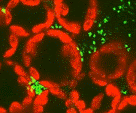Plant Pathology, Department of

Department of Plant Pathology: Faculty Publications
Document Type
Article
Date of this Version
2-2017
Citation
Published in Pest Management Science 73 (2017), pp. 1822–1829. doi:10.1002/ps.4544
Abstract
Background: Monilinia fructicola is a diverse pathogen of pome and stone fruits that causes severe economic losses each year. However, little is known about inoculum flow within or between orchards and pathogen establishment in an orchard, because few methods exist for detecting diversity or tracking isolates over time. SSR loci are an effective option, but may be confounded by a high degree of mutability and potential sensitivity to abiotic stress.
Results: Through transcriptome analysis, we identified novel markers mrr1, DHFR and MfCYP01 and validated stability of these markers under fungicide stress in natural infection sites. Nucleotide variation within mrr1, DHFR and MfCYP01 sequences differentiated isolates at all spatial scales: within the same infection site, between trees and between two farms. Sequenced regions were also effective for matching isolates collected from blossoms at the beginning of the season to progeny in cankers obtained at the end of the season.
Conclusions: Collectively, results show that mrr1, DHFR and MfCYP01 are able to accurately differentiate M. fructicola isolates at the population level, can be used to track isolates over time, and are more stable than SSRs under external stresses. Either by themselves or combined with SSR markers, these gene-encoding regions are a much-needed tool for better understanding M. fructicola population dynamics.
Includes supplemental materials.


Comments
Copyright © 2017 Society of Chemical Industry. Published by John Wiley & Sons. Used by permission.